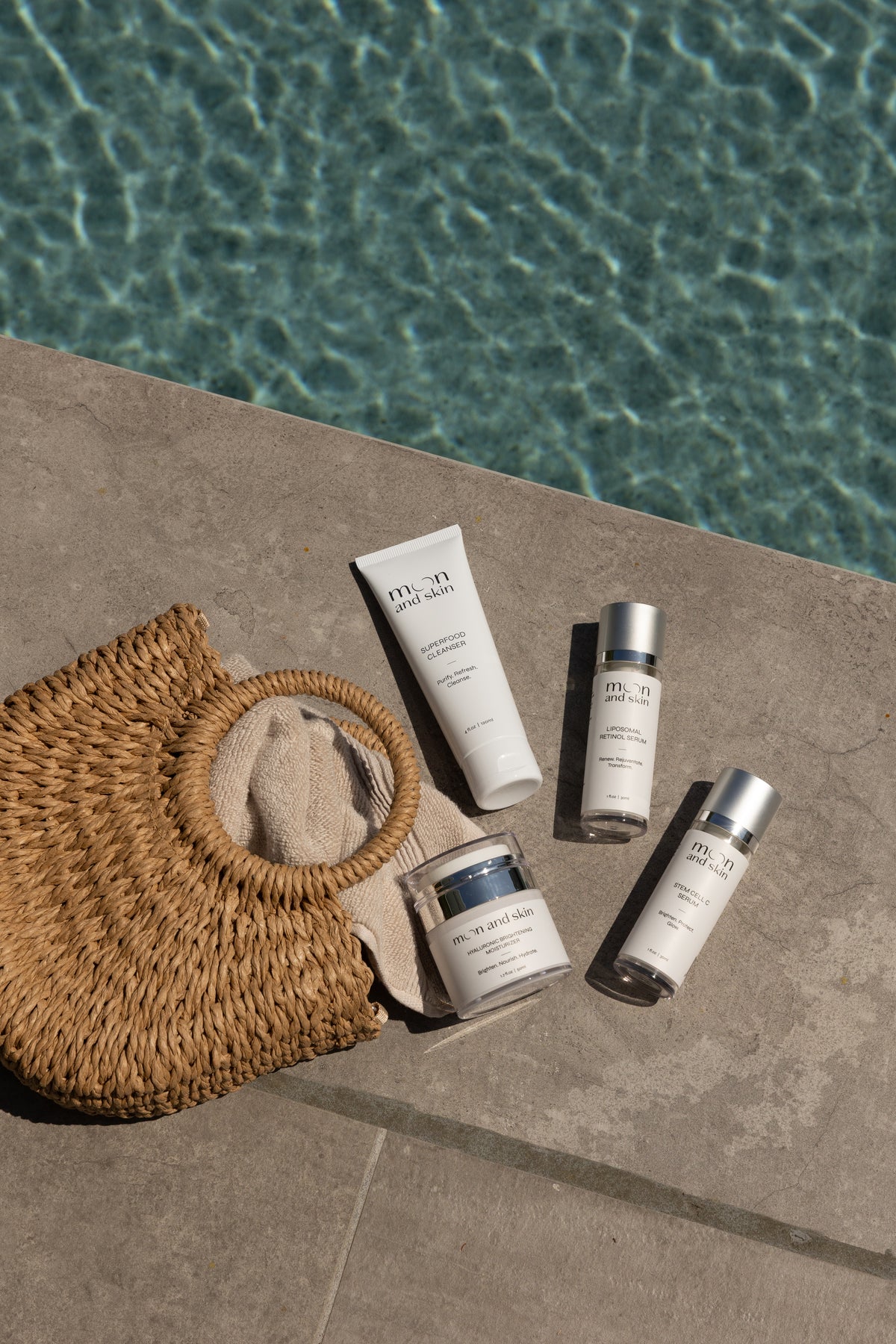Table of Contents
Introduction
Did you know that our skin naturally sheds around 30,000 to 40,000 dead skin cells every minute? This incredible process is vital for maintaining healthy skin, but sometimes it needs a little help. As we age, this natural exfoliation process slows down, leading to dull, rough skin that can feel less vibrant. If you've ever looked in the mirror and noticed that your skin is looking lackluster or feeling rough, you might be wondering: how can I rejuvenate my skin effectively?
At Moon and Skin, we understand that navigating the world of exfoliation can be confusing. With various methods and products available, it's crucial to know how to exfoliate your body safely and effectively. In this post, we will explore everything you need to know about body exfoliation, including the benefits, methods, and best practices. Our goal is to empower you to make informed skincare choices that suit your unique skin type and lifestyle.
Join us as we break down the fundamentals of body exfoliation, helping you achieve smoother, healthier skin that glows with vitality.
What is Exfoliation?
Exfoliation is the process of removing dead skin cells from the surface of the skin. This can be done through various methods, including mechanical (physical) and chemical techniques. Let's delve deeper into these two types of exfoliation.
Mechanical Exfoliation
Mechanical exfoliation involves physically scrubbing the skin to remove dead cells. This can be achieved using tools such as:
- Exfoliating Scrubs: These contain small granules that help slough off dead skin.
- Body Brushes and Sponges: These tools help to buff away dead skin through gentle friction.
- Pumice Stones: Often used for hard areas like feet, these stones can effectively smooth rough patches.
Mechanical exfoliation provides immediate results, leaving your skin feeling smooth and refreshed. However, it's essential to be gentle to avoid micro-tears or irritation.
Chemical Exfoliation
Chemical exfoliation utilizes active ingredients to dissolve dead skin cells. This method can be more effective than mechanical exfoliation, as it acts below the surface. Common chemical exfoliants include:
- Alpha Hydroxy Acids (AHAs): Water-soluble acids like glycolic and lactic acid that work on the skin's surface.
- Beta Hydroxy Acids (BHAs): Oil-soluble acids like salicylic acid that penetrate deeper, making them suitable for oily and acne-prone skin.
Chemical exfoliation often leads to a more uniform skin tone and improved texture. However, it requires careful selection based on your skin type and sensitivity.
Why Exfoliation is Important
Exfoliation is more than just a cosmetic treatment; it is a fundamental step in a healthy skincare routine. Here are some compelling reasons to incorporate exfoliation into your body care regimen:
1. Removes Dead Skin Cells
By effectively removing dead skin cells, exfoliation promotes a smoother surface and helps prevent clogged pores. This can reduce the occurrence of breakouts and dullness.
2. Enhances Product Absorption
When the skin is free of dead cells, it can better absorb other skincare products like moisturizers and serums. This means that your skincare routine will be more effective, making the most of your products.
3. Stimulates Circulation
The process of exfoliation can increase blood flow to the skin, promoting healthier skin cell turnover. This can lead to a more radiant complexion and improved skin health overall.
4. Prevents Ingrown Hairs
Regular exfoliation can help prevent ingrown hairs, particularly in areas prone to shaving or waxing. By keeping hair follicles clear of dead skin, you can reduce irritation and bumps.
5. Brightens Skin Tone
Exfoliating can help achieve a more even skin tone by reducing dark spots and discoloration. This is especially effective with chemical exfoliants that target pigmentation issues.
Choosing the Right Exfoliation Method
Not all exfoliation methods are suitable for every skin type. Understanding your skin type and its unique needs is key to effective exfoliation. Here are some guidelines to help you choose the right method for your body:
1. Sensitive Skin
For sensitive skin, we recommend gentle chemical exfoliants, such as those containing lactic acid or fruit enzymes. Avoid mechanical exfoliation, as it can lead to irritation.
2. Dry Skin
If you have dry skin, opt for mild chemical exfoliants that hydrate as they exfoliate. Avoid harsh scrubs, which can exacerbate dryness. Our Hyaluronic Brightening Moisturizer is perfect for following up your exfoliation routine.
3. Oily Skin
Oily skin can benefit from both mechanical and chemical exfoliation. Consider using a scrub or a product with salicylic acid to help control excess oil and prevent breakouts.
4. Combination Skin
Combination skin may require a blend of both methods. Use gentle mechanical exfoliation on drier areas and chemical exfoliants on oilier sections.
5. Normal Skin
If you have normal skin, you can experiment with both mechanical and chemical methods. Just be mindful of how your skin reacts and adjust your routine accordingly.
How to Exfoliate Your Body: A Step-by-Step Guide
Now that we understand the importance of exfoliation and how to choose the right method, let's go through a practical guide on how to exfoliate your body effectively.
Step 1: Gather Your Tools and Products
Before you start exfoliating, gather the necessary tools and products. Depending on your chosen method, this may include:
- An exfoliating scrub or chemical exfoliant
- A body brush or sponge
- A lukewarm shower or bath
Step 2: Cleanse Your Skin
Start by cleansing your skin with a gentle body wash, like our Superfood Cleanser. This step prepares your skin for exfoliation by removing surface dirt and oils.
Step 3: Apply Exfoliant
For Mechanical Exfoliation:
- Use your chosen scrub: Apply a small amount of scrub to your damp skin.
- Massage gently: Use circular motions, focusing on areas prone to dryness or roughness, such as elbows and knees.
- Rinse thoroughly: Use lukewarm water to rinse away the scrub, ensuring no residue is left behind.
For Chemical Exfoliation:
- Apply the product: Use a cotton pad or your fingers to apply the chemical exfoliant to your skin.
- Follow instructions: Adhere to the recommended time specified on the product label; generally, this is around 5-10 minutes.
- Rinse off: After the designated time, rinse thoroughly with lukewarm water.
Step 4: Moisturize Immediately
After exfoliating, it's crucial to restore moisture to your skin. Apply a nourishing moisturizer, such as our Hyaluronic Brightening Moisturizer, immediately after rinsing off the exfoliant. This step helps to lock in hydration and keep your skin feeling soft.
Step 5: Follow a Consistent Schedule
To achieve the best results, establish a consistent exfoliation schedule based on your skin type:
- Sensitive & Dry Skin: Exfoliate once a week.
- Normal & Combination Skin: Exfoliate 1-2 times a week.
- Oily Skin: Exfoliate 2-3 times a week.
Listen to your skin and adjust your routine as necessary to avoid over-exfoliation and irritation.
The Benefits of Regular Exfoliation
Incorporating regular exfoliation into your skincare routine can yield numerous benefits, including:
- Smoother Texture: Exfoliation helps to refine skin texture, making it feel soft and smooth.
- Improved Radiance: Regularly removing dead skin leads to a brighter, more vibrant complexion.
- Healthier Skin: By promoting cell turnover and preventing clogged pores, exfoliation contributes to overall skin health.
- Enhanced Product Efficacy: Exfoliation allows other skincare products to penetrate more effectively, maximizing their benefits.
When to Avoid Exfoliation
While exfoliation is beneficial, there are circumstances in which it should be avoided. This includes:
- Sunburned Skin: Exfoliating sunburned skin can exacerbate irritation and prolong healing.
- Open Wounds or Cuts: Avoid exfoliating areas with cuts or wounds to prevent further irritation.
- Active Skin Conditions: If you have conditions such as rosacea, eczema, or psoriasis, consult with a dermatologist before exfoliating.
Frequently Asked Questions (FAQ)
1. How often should I exfoliate my body?
The frequency of exfoliation depends on your skin type. Generally, it’s recommended to exfoliate once a week for sensitive or dry skin, and up to 2-3 times a week for oily skin.
2. Can I exfoliate every day?
Daily exfoliation is usually too harsh for most skin types and can lead to irritation. Stick to a consistent weekly schedule for the best results.
3. What should I do after exfoliating?
Always follow exfoliation with a hydrating moisturizer to replenish moisture. This is crucial for maintaining skin health.
4. Is it okay to use both mechanical and chemical exfoliants?
Yes, but be cautious. Consider alternating between the two methods instead of using them on the same day to avoid over-exfoliating.
5. What if my skin feels irritated after exfoliation?
If you experience irritation, stop exfoliating until your skin has healed. Consider using gentler exfoliants or adjusting your frequency.
Conclusion
Exfoliation is an essential step in achieving healthy, glowing skin. By understanding your skin type and choosing the right method, you can enjoy the benefits of smoother, brighter skin. Together, we can navigate the world of body care and make informed decisions that empower your skincare journey.
Ready to enhance your skincare routine? Explore our Bundle & Save collection to create a complete regimen that supports your skin at every phase of life. Experience the transformative effects of our core products, including the Stem Cell C Serum, the Liposomal Retinol Serum, and our Superfood Cleanser. Embrace your journey to radiant skin with Moon and Skin!







